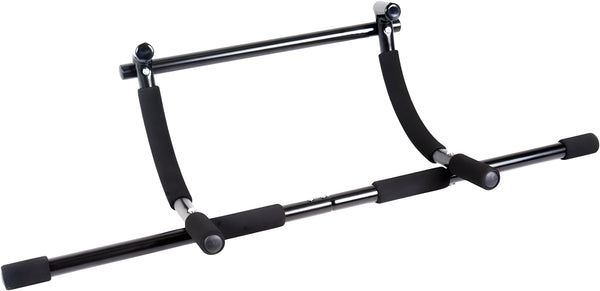Your Cart is Empty
December 12, 2023 3 min read
Resistance bands are a great tool for adding resistance and providing assistance during pull-up exercises. Using a resistance band can help you achieve a greater range of motion, increase the amount of tension on your muscles, and ultimately help you work toward achieving more pull-ups. Resistance bands come in a variety of sizes, lengths, and resistance levels, so it’s important to choose a band that is appropriate for your skill level.
Shop The Collection: Pull Up BarsWhen selecting a resistance band for pull-up exercises, the most important factor to consider is the size and resistance level of the band. The size of the band will determine how much resistance is provided and the resistance level will determine how challenging the exercise is. Generally speaking, larger bands provide more resistance and are best for more advanced exercisers, while smaller bands provide less resistance and are better suited for beginners. It’s also important to select a band that is long enough to accommodate your height and reach.
 Shop The Gear: CAP Barbell Xtreme Doorway Pull Up Bar, $27.99 USD
Shop The Gear: CAP Barbell Xtreme Doorway Pull Up Bar, $27.99 USD
Once you have selected the right band, it’s important to use it correctly. When using a resistance band for pull-up exercises, the band should be attached securely to an anchor point above your head. The anchor point should be high enough so that the band is not pulled too taut when you are in the full up position. Once the band is attached, you will then need to loop the band around your waist or chest, depending on the type of pull-up you are performing.
1. Select a resistance band that is appropriate for your skill level and secure it to an anchor point above your head.
2. Loop the band around your waist or chest, depending on the type of pull-up you are performing.
3. Position yourself beneath the pull-up bar and grab the bar with an overhand grip.
4. Engage your core and glutes and use your legs to help lift your body up until your chin is above the bar.
5. Hold the position for a few seconds before slowly lowering your body back down.
6. Repeat the movement for the desired number of repetitions.
1. Make sure to select a band with the proper resistance level. Choose a band that is challenging but still allows you to complete each repetition with good form.
2. Keep your core engaged throughout the entire workout to protect your lower back.
3. Focus on the eccentric (lowering) portion of the exercise as this is where you will get the most benefit from the band.
4. Take your time and avoid jerky movements. This will ensure you are getting the most out of each repetition.
5. Increase the resistance as you get stronger. This will help you continue to challenge yourself and make progress in your pull-up exercises.
Resistance bands are a great tool for adding resistance and providing assistance during pull-up exercises. They come in a variety of sizes and resistance levels, so it’s important to choose a band that is appropriate for your skill level. When using a resistance band for pull-up exercises, it’s important to attach it securely to an anchor point above your head and loop it around your waist or chest, depending on the type of pull-up you are performing. Additionally, it’s important to keep the following tips in mind in order to get the most out of your resistance band workout.
Shipping Protection gives you peace of mind while saving you time and money.
Shipping Protection provides coverage for eligible orders that are lost or damaged in transit, or stolen after delivery has been confirmed by the carrier. MAGMA Fitness, through its partners, administers the protection program and may receive compensation for these services. Coverage is subject to the terms, conditions, and exclusions outlined in our Shipping Protection Terms & Conditions.